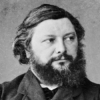Gustave Courbet

Gustave Courbet
Jean Désiré Gustave Courbetwas a French painter who led the Realist movement in 19th-century French painting. Committed to painting only what he could see, he rejected academic convention and the Romanticism of the previous generation of visual artists. His independence set an example that was important to later artists, such as the Impressionists and the Cubists. Courbet occupies an important place in 19th-century French painting as an innovator and as an artist willing to make bold social statements through his...
NationalityFrench
ProfessionPainter
Date of Birth10 June 1819
CityOrnans, France
CountryFrance
To be able to translate the customs, ideas and appearance of my times as I see them - in a word, to create a living art - this has been my aim.
I hope to live all my life for my art, without abandoning my principles one iota, without . . . having painted as much as you can cover with your hand, to please somebody or in order to sell the picture more easily.
Art or talent, for an artist, is merely a means of applying his personal faculties to the ideas and the things of the period in which he lives.
It is fatal for art if it is forced into official respectability and condemned to sterile mediocrity.
France is the only nation in which astoundingly small numbers of civilized patrons reside.
When I am no longer controversial, I will no longer be important
The expression of beauty is in direct ratio to the power of conception the artist has acquired.
Painting is an essentially concrete art and can only consist of the representation of real and existing things. It is a completely physical language, the words of which consist of all visible objects. An object which is abstract, not visible, non-existent, is not within the realm of painting.
The principle of realism means denial of the ideal.
Beauty lies in nature and reveals, once the artist has perceived it, its own expressive power.
On the left is the realist tradition of the 19th century, with its impulse to social description, radical criticism and meditation on things as they are... culminating in Courbet at his mightiest (The Studio, The Funeral at Ornans and a portrait of a trout that has more death in it than Rubens could get in a whole Crucifixion).
I have never seen either angels or goddesses, so I am not interested in painting them.
Painting is the representation of visible forms. The essence of realism is its negation of the ideal.
Beauty, like truth, is relative to the time when one lives and to the individual who can grasp it.